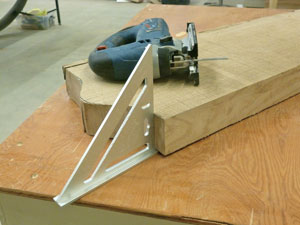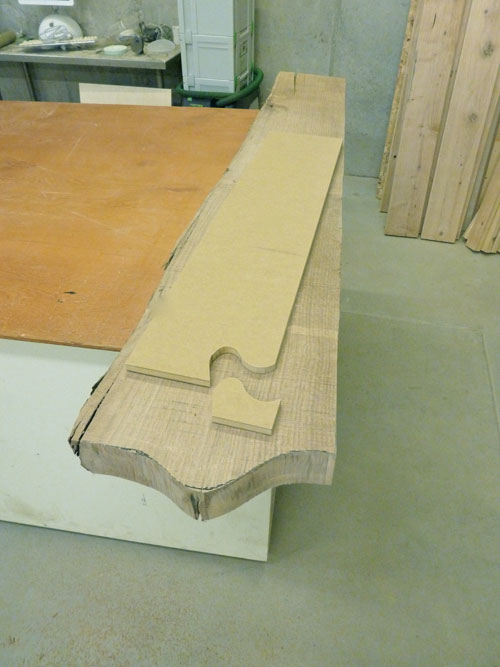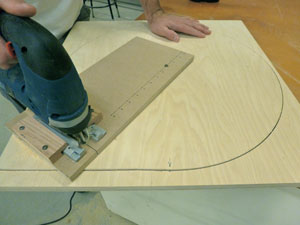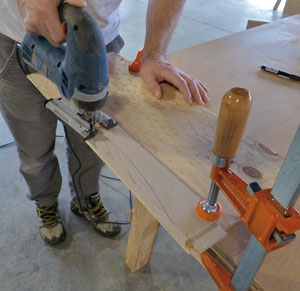 When I started woodworking, I had a lot of tools to acquire. Of course, the table saw was the first big purchase. After a while, I got a really nice sliding miter saw, and then a planer. One of the 'big' tools that took me a long time to acquire was a bandsaw. I love a good bandsaw, don't get me wrong... in fact, my co-operative shop had three! But I never forget how useful a high-quality jigsaw can be in fine woodworking and furniture making, and continue using one in my shop today.
When I started woodworking, I had a lot of tools to acquire. Of course, the table saw was the first big purchase. After a while, I got a really nice sliding miter saw, and then a planer. One of the 'big' tools that took me a long time to acquire was a bandsaw. I love a good bandsaw, don't get me wrong... in fact, my co-operative shop had three! But I never forget how useful a high-quality jigsaw can be in fine woodworking and furniture making, and continue using one in my shop today.

 One of the things that makes a jigsaw so versatile is the variety of blades available. Here are five blades specifically made for cutting wood; a short, thin blade that excels at nimble tight curves, a super aggressive blade for demolition work, a traditional up-cut blade for clean cuts, a down-cutting blade for a clean top surface, and lastly, a long, wide blade for cutting thick timbers. Additionally, there are blades specifically for steel, aluminum and composites too.
One of the things that makes a jigsaw so versatile is the variety of blades available. Here are five blades specifically made for cutting wood; a short, thin blade that excels at nimble tight curves, a super aggressive blade for demolition work, a traditional up-cut blade for clean cuts, a down-cutting blade for a clean top surface, and lastly, a long, wide blade for cutting thick timbers. Additionally, there are blades specifically for steel, aluminum and composites too.
 This slab of red oak is super heavy... maybe 70 or 80 pounds! While a jigsaw is an excellent tool for processing rough timber in general (as opposed to a circular saw which can bind and kick back), it can even cut complex shapes on the end of 3-inch thick slabs like this one. By bringing the tool to my work I save time, and more importantly, my back.
This slab of red oak is super heavy... maybe 70 or 80 pounds! While a jigsaw is an excellent tool for processing rough timber in general (as opposed to a circular saw which can bind and kick back), it can even cut complex shapes on the end of 3-inch thick slabs like this one. By bringing the tool to my work I save time, and more importantly, my back.
 The jigsaw is capable of remarkable precision too. The blade barely wandered while cutting this behemoth plank. Jigsaws made today have a guide bushing that controls the blade as it oscillates up and down, making it much more accurate than models made in years gone by. As with other tools, dull blades and incorrect feed rate dramatically affect tracking.
The jigsaw is capable of remarkable precision too. The blade barely wandered while cutting this behemoth plank. Jigsaws made today have a guide bushing that controls the blade as it oscillates up and down, making it much more accurate than models made in years gone by. As with other tools, dull blades and incorrect feed rate dramatically affect tracking.
 Another advantage of the jigsaw is the ability to change the blade in a split second. To switch from one blade to another on a bandsaw takes at least 10 minutes. The guides have to be adjusted, and the blade tensioned properly. In contrast, changing the blade in a jigsaw is a flip of the thumb and twist of a finger. Making these two cuts on a bandsaw would have taken 30 minutes!
Another advantage of the jigsaw is the ability to change the blade in a split second. To switch from one blade to another on a bandsaw takes at least 10 minutes. The guides have to be adjusted, and the blade tensioned properly. In contrast, changing the blade in a jigsaw is a flip of the thumb and twist of a finger. Making these two cuts on a bandsaw would have taken 30 minutes!
 You may ask, well what about cutting circles; the bandsaw does that really well. I made a simple jig for cutting circles with my jigsaw too. Two pieces of wood 'clamp' the base of my jigsaw to an armature with a ruler drawn on it. The work piece has to hang off the edge of a table and rotate as you cut, but that isn't that big of a deal. Easy!
You may ask, well what about cutting circles; the bandsaw does that really well. I made a simple jig for cutting circles with my jigsaw too. Two pieces of wood 'clamp' the base of my jigsaw to an armature with a ruler drawn on it. The work piece has to hang off the edge of a table and rotate as you cut, but that isn't that big of a deal. Easy!
 If I need to cut a curve on a smaller piece, like this arched stretcher, I clamp the stretcher to a sacrificial piece of inexpensive plywood and hang it off my bench. The plywood supports the waste piece, which in turn provides a stable base for my jigsaw to ride on as I make the cut.
If I need to cut a curve on a smaller piece, like this arched stretcher, I clamp the stretcher to a sacrificial piece of inexpensive plywood and hang it off my bench. The plywood supports the waste piece, which in turn provides a stable base for my jigsaw to ride on as I make the cut.
 These dovetails are an example of how quick and precise a jigsaw can be. It took me about an hour to cut the tails and pins with a jigsaw and clean the cuts with a chisel. Once I apply glue, this box will literally last a lifetime. While I wouldn't recommend the jigsaw for super-fine dovetails, the jigsaw can certainly make work-a-day dovetails perfect for some projects. If I am only removing waste and then cleaning up with a router, I find the jigsaw gives me a great sightline for cleaning up big planks before I move in with the calipers.
These dovetails are an example of how quick and precise a jigsaw can be. It took me about an hour to cut the tails and pins with a jigsaw and clean the cuts with a chisel. Once I apply glue, this box will literally last a lifetime. While I wouldn't recommend the jigsaw for super-fine dovetails, the jigsaw can certainly make work-a-day dovetails perfect for some projects. If I am only removing waste and then cleaning up with a router, I find the jigsaw gives me a great sightline for cleaning up big planks before I move in with the calipers.
It is true, there are a couple of things that the bandsaw can do that the jigsaw cannot. Most glaringly, the jigsaw in no way can facilitate re-sawing for veneer or maximizing thick boards. This job requires a continuous blade and a fence, neither inherent to the jigsaw. The other is making very small or thin curved parts, where the table of a bandsaw provides a stable and safe surface for cutting. But I would like to be on the record as an advocate of the jigsaw as a fine woodworking tool. If you've been avoiding curves in your woodshop because you don't have a bandsaw yet, put that assumption aside, and go invest in a decent jigsaw ($100.00 will get you a very nice jigsaw these days). Many projects with curves came out of my shop before I had a bandsaw. Now that I have access to a bandsaw, I certainly don't regret owning a jigsaw... it just makes me faster and more versatile than ever.
Photos By Author


Praise the jigsaw! So many furniture makers look down on the jigsaw, and I think it relates to their teachers and the low quality of jigsaws in the past. Necessity dictated my jigsaw use, and now it is an everyday tool. Get a cordless and learn how easy they are to use!
For cuts like your stretcher cut I built a box that has a 2' x 2' top and mount my jigsaw on the bottom of the top with the blade sticking thru. If you drill a hole and add a zero clearance insert you can then cut like a scroll saw and because the blade is cutting on the down stroke you don't get tear out on your piece.
Could you take a bit more about feed rate and deflection? I have a Ryobi 6.1 amp Jigsaw. , and I tried to cut 2 pieces of 3/4" Oak plywood so I could get identical cuts, however, to my dismay I ended with a wicked angle on the bottom piece. (I watch some guy in a video do it and it worked for him. The top piece wasn't very all that great either..
Hi MATV and jpbrady- The jigsaw is such an amazing tool, but one that often goes overlooked. I bought my first jigsaw at the same time I bought a reciprocating saw... I just couldn't stomach the thought of buying a tool designed for demolition when all I wanted to do was make things, so I compensated by buying one that takes things apart, and another for creating! Seth
A jigsaw was all I had for several years and I got very good at adapting it to any of the projects I had on the workbench.
I agree Seth, the Jigsaw is a very versatile saw. Even though I have a BS I use the jigsaw (or as some call it sabre saw) frequently. The neat thing is that, as you say, it can cut other materials as well, such as, steel and aluminum....a real advantage.
Hi MATV and jpbrady- The jigsaw is such an amazing tool, but one that often goes overlooked. I bought my first jigsaw at the same time I bought a reciprocating saw... I just couldn't stomach the thought of buying a tool designed for demolition when all I wanted to do was make things, so I compensated by buying one that takes things apart, and another for creating! Seth
A jigsaw was all I had for several years and I got very good at adapting it to any of the projects I had on the workbench.
I agree Seth, the Jigsaw is a very versatile saw. Even though I have a BS I use the jigsaw (or as some call it sabre saw) frequently. The neat thing is that, as you say, it can cut other materials as well, such as, steel and aluminum....a real advantage.